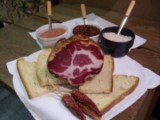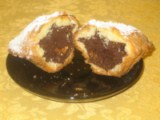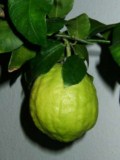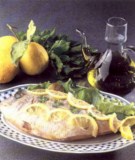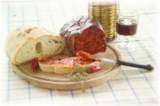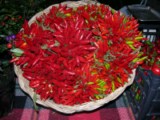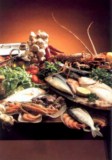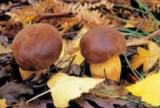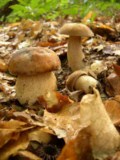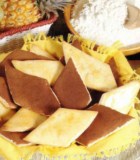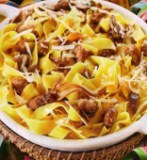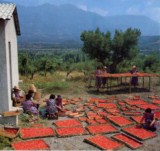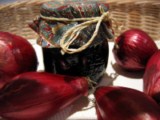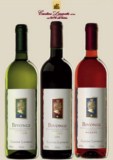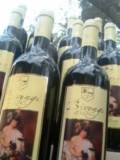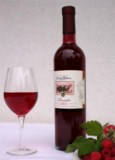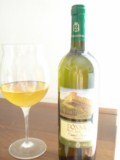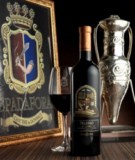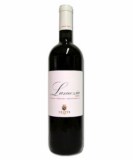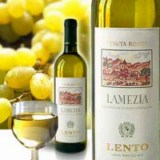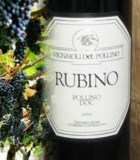|
CALABRIA FOOD & WINE - CALABRIA - SOUTH ITALY
Calabrian Cooking
Cakes
Cheses
Wines
The Bergamotto
Cooking & Wine by Region
WHERE TO EAT - WHERE TO HAVE FUN - SPONSORS |
| |
|
| |
|
YOUR ADVERTISEMENT BANNER HERE |
Calabrian Cooking
Calabrian cooking has become immensely popular. In the past few years, connoisseurs such as Veronelli and Carnacina have often included Calabrian recipes in their references to Italian gastronomy. In addition a lot of indirect publicity has been provided on an international scale by dietologists who, with the Americans to the fore, have discovered that Mediterranean cooking and particularly Calabrian, is one of the healthiest.
Olive oil is now seen as highly nutritious, good for the arteries and withstanding change at high temperatures. The small red chilli pepper turns out to be a vasodilator and whole meal bread fibre is good for the digestive system.
Calabrian cooking is healthy in fact, because it is simple and plain. Nevertheless, imagination and necessity in people often isolated for long periods have supplemented this simplicity with inventiveness in food preparation. Numerous historical references attributing noble origins as well to Calabrian dishes are found in Greek and Latin literature, preserved for us by 16th century scholars, such as Girolamo Marafioti.
The delicate fish recipes of Sybaris for example, were renowned throughout the classical world. Admittedly, the most original Calabrian recipes call for lengthy preparation and a lot of work, and the housewife may have to start cooking at dawn, often using methodical ways. For this reason, apart from the many characteristic restaurants, rural traditional cooking is found mostly in the inland villages, where few of the women go out to work. The "fusilli di casa" is common; this home made pasta is rolled around metal or bamboo sticks (in Greek Calabria, were called cannici).
At Vibo Valentia, this pasta is known as "fileia". It is always served with a meat sauce, made of well-cooked pork, often mixed with veal and goat meat (in the Greek area, Bova). Another popular dish is vegetable soup, or pasta and vegetable soup, e.g. pasta and beans, pasta and broccoli, pasta and broad beans, polenta and cabbage, rice and endive, pasta and courgettes, pasta and artichokes, pasta and peas.
The main ingredient of each dish is olive oil, never lacking in the Calabrian larder, together with home made tomato sauce, aubergines and salami.
The so called small meats, lamb, kid and goat, are renowned, and a well-known dish is "Capra alla bovese" (Vutana): goat meat boiled with herbs is popular, as is char grilled kid, eaten throughout the entire region.
Pork is an important ingredient, and a popular dish is the "frittula", hot pig's skin eaten with warm bread. Butchers' shops in Reggio Calabria still keep a hot pan near the door, in which the tastiest morsels of pork are cooked in their own fat.
Catanzaro is well known for its "murzeddu or morsello", its own specialty, made of tripe, cow's heart and lungs, well seasoned with herbs and spices and served in a "pitta", a round roll of flat home baked bread.
An interesting white meat dish at Altomonte, is roast cockerel; a classical fish dish is sword- fish caught with fishing nets in spring off the Violet Coast between
Villa San Giovanni and Palmi. Traditionally, it is grilled in an herb, olive oil and vinegar sauce or served "alla marinara" with tomato and parsley.
Traditional to Calabria is "baccala' spugnato", soaked salted codfish which In some areas acquires a particular flavor, probably from the water. "Baccala'" can be cooked in many ways, but traditionally it is fried in batter or baked "alla molinara" with fresh tomatoes and potatoes.
In the Crotone area, "sardella salata", small blue fish salted and seasoned with powdered red chilli peppers and olive oil and eaten spread on bread as an appetizer.
Aubergines are one of the basic ingredients of Calabrian cooking, and are extensively used. Every part of this amazing vegetable is used, including the skin, with excellent results. Often the aubergine is served as a main course such as "melanzane alla parmiggiana" baked with Olive oil, tomato sauce and Parmesan cheese. But many other recipes include aubergines, like "melanzane ripiene" (stuffed), "caponata" (fried aubergines, peppers, fresh tomatoes and onions), roasted, skinned and seasoned with olive oil and garlic, and grilled with olive oil, garlic and parsley.
Cakes
There is also a vast assortment of cakes and perhaps more than any other aspect of Calabrian cookery, sweet things are most intimately linked with genuine local tradition, especially at Christmas and Easter. This probably arises from the fact that, in a relatively poor economy, sweets and cakes are considered luxuries to be enjoyed only on great occasions.
In almost the whole region at Easter, the "sgute" or "aggute" or "cuddhuraci"or "cuzzupe", cakes are made, in the shape of a handbag with a handle. One or more hardboiled eggs are inserted in the pastry and the top is decorated with symbols.
Another traditional cake is the "nacatula", once eaten at weddings, and also at Carnival time, fried in olive oil.
The "mostacciolo", made of flour, fig honey and almonds, is another genuinely traditional Calabrian cake, found all over the region, but of great importance, for the local economy, at Soriano Calabro, in the Catanzaro serre. "Mostacciolo" or "nzuddo"can still be bought at any fair and in displayed in the characteristic "mustazzolari" chests. It is made in all shapes and is often a veritable haut relief, trimmed with tinfoil, and is still sometimes given in inland towns as a symbolic engagement or wedding present.
The figures on it often recall pagan motives (babbaluti)or early Christian fish and bird symbols.
"Petrali"are made of fruit and belong to the tradition of the Greek areas of Calabria, though they are made with variations by Reggio di Calabria confectioners.
Another typical cake is the "pignolata", made of small balls of sweet pastry fried in olive oil and stuck together with honey, found in most of the region.
Torrone (nougat) is made at home but also industrially, and is thus of economic importance. Traditionally a Christmas sweet, it is made of honey, sugar, almonds and chocolate. Another Christmas cake is the "pitta di San Martino", made of candied fruit (the polistena "pitta" is particularly good).
Cheese
As far as cheese is concerned, mention must be made of the delicious Sila and Pollino cheeses, particularly caciocavallo, a soft, fairly strong provola, and "butirro", provolone with a butter centre. Excellent is the cow's milk cheese made in very small quantities by the monks of the San Bruno monastery, at Serra San Bruno, like the goat's milk cheeses from Aspromonte, made at Bova, Roccaforte del Greco, Staiti, Motta San Giovanni and Roghudi, Connoisseurs consider the Calabrian goat's milk cheeses as some of the best.
Wines
BIVONGI CIRO' DONNICI GRECO DI BIANCO LAMEZIA MELISSA POLLINO SANT'ANNA SAVUTO VERBICARO
WHERE TO EAT - WHERE TO HAVE FUN - SPONSORS |
| |
|
| |
|
YOUR ADVERTISEMENT BANNER HERE |
Calabria has a vast range of wines, and each part of the countryside seems to have its own. Much appreciated by the ancient Greeks and Romans, Virgil and Pliny sing the praises of the fruit of the vine, and it is certain that in antiquity, Calabria was the land of wines (hence the name Enotria), and over a hundred varieties of vine were known there at the time of the Greeks.
Generally speaking, Calabrian red wines are better than the white, and such is their strength and body that they are widely used to "cut" a large number of Italian wines, including the renowned Barolo, as well as foreign.
The controlled origin wines (DOC) in Calabria are now Ciro' Melissa Lametia, Savuto (along the Savuto river), Donnici, (upper Crati valley, Cosenza province) Greco di Gerace (a white wine, Gerace area) and Sant'Anna (isola di Capo Rizzuto).
Apart from these wines, of which the world famous Ciro' is outstanding and described as the oldest wine on earth, many others deserve a mention, and though well known, have not been accorded the DOC recognition.
These include Pellaro, originating a few miles south of Reggio di Calabria, known for its robust quality, flavor and strength (14-16°); Kalipea, made at Locri, golden in color; Limbadi (Vibo Valentia), a good table wine; Rossano, made in the area near the town, ruby colored with a high alcoholic content; Verbicaro (Cosenza), from the Lao river basin.
A curiosity is the Trasfigurato wine from Seminara, kept in terracotta containers and smoked, There are hundreds of other wines, all good, and the search for Calabrian wines can be a fascinating pastime for visitors wishing to get to know Calabria, not only for what it is but for what it has to offer.
BIVONGI
Go to Riace Town
Production area: Province of Reggio Calabria in common: Bivongi, Fireplaces, Monasterace, Pazzano, Placanica, Riace, Stignano and style in the province of Catanzaro in the town of Guardavalle
Bivongi Red and Rosé Vines: grapes Gaglioppo and Greek black, alone or with 30-50% with those of Nocera and/or Calabrese and/or Castiglione (30-50%) with addition of other grapes black grapes (maximum 10%) and white berries (maximum 15%) of the area.
Bivongi White Vines: Greek white grape, Guardavalle and mutton, alone or with 30-50%, with those of white Malvasia and/or Ansonica for 30-50% of other grapes and white grapes of the area (30%).
Bivongi Red Features:
- Color: ruby red;
- Smell: red, more or less tending to garnet with aging;
- Taste: dry, harmonious, pleasant, fruity;
- Minimum total alcoholic strength by volume: 12% vol;
Bivongi White Features:
- Color: yellow, more or less intense;
- Smell: vinous and pleasant;
- Taste: dry, harmonious, fruity;
- Minimum total alcoholic strength by volume: 10.50% vol;
Serving temperature and Food Associations:
Red
- Temperature: 16-18° C
- Matching: cheese and salami from Calabria
White
- Temperature: 8-10° C
- Matching: fish dishes, regional soups, vegetables, and cheese slightly seasoned
CIRO'
Go to Cirò Town
Production area: Province of Catanzaro in common: Ciro and Ciro Marina, Melissa and Crucoli
Cirò Red and rosé Vines: grapes Gaglioppo for 95%, possible addition of grapes Trebbiano Toscano and Greek white for a maximum of 5%.
Cirò White Vines: white grape Greek to at least 90%, Trebbiano Toscano possible addition of a maximum of 10%.
Cirò Red Features:
- Color: ruby red;
- Smell: pleasant, delicate, intensely winy;
- Taste: dry, full bodied, warm, harmonious, velvety with age;
- Minimum total alcoholic strength by volume: 12.50% vol;
Cirò White Features:
- Color: straw yellow, more or less intense;
- Smell: vinous and pleasant;
- Taste: dry, harmonious, delicate, lively and characteristic;
- Minimum total alcoholic strength by volume: 11% vol;
Serving temperature and Food Associations:
Red
- Temperature: 16-18°C
- Matching: Pasta with meat sauces, meat sauce, venison and salami from Calabria
White
- Temperature: 8-10°C
- Matching: tuna, swordfish, vegetables, ricotta
DONNICI
Go to Donnici Town
Production area: Province of Cosenza in common: Aprigliano, Cellara, Cosenza, Dipignano, Figline Vegliaturo, Mangone, Paterno Calabro, Pedace, Piane Crati and Pietrafitta
Donnici White Vines: 50% minimum of rams white grapes, 30% max Greek white and/or Malvasia white and/or Pecorello white grapes possible addition of other white grapes for a maximum of 20%.
Donnici Red Vines: grapes Gaglioppo 50%, 10% minimum of Greek black, up 10% Malvasia Bianca and/or Greek white and/or Mantonico white and/or Pecorello white 10% white 20% red grapes possible addition of other local vineyards.
Donnici White Features:
- Color: white with yellow or greenish;
- Smell: Fresh, vinous, pleasant, characteristic;
- Taste: dry, full, harmonious, sometimes fruity;
- Minimum total alcoholic strength by volume: 11% vol;
Features Donnici Red:
- Color: from ruby to cherry;
- Smell: vinous, pleasant;
- Taste: full, dry and harmonious;
- Minimum total alcoholic strength by volume: 12% vol;
Serving temperature and Food Associations:
White
- Temperature: 8-10° C
- Matching: fish, vegetables, cheese seasoned slightly
Red
- Temperature: 16-18° C
- Matching: white meat, aubergines, peppers, cheese and salami from Calabria
GRACO DI BIANCO
Go to Reggio Calabria Town
Production area: Province of Reggio Calabria in common: Bianco and Casignana
Greco di Bianco Vines: 95% of the grape vine Greco Bianco.
Greco di Bianco Features:
- Color: yellow to golden amber with any;
- Smell: intense and persistent, large, floral, slightly aromatic, with delicate hints of citrus blossom and honey, dried figs and candied fruit;
- Taste: sweet, hot, rather than soft, slightly crisp, fairly full-bodied, very strong-bodied, fairly balanced;
- Minimum total alcoholic strength by volume: 17% vol;
Serving temperature and Food Associations:
- Temperature: 10-12°C
- Matching: structured and consistent sweets and cakes, strong, hard cheeses, also appropriate out of meals
LAMEZIA
Go to Lamezia Town
Production area: Province of Catanzaro in common: Lamezia Terme, Curinga, Falerna, Feroleto Antico, Gizzeria, Maida, Pianopoli, San Pietro a Maida, Province of Vibo Valentia in the town of Francavilla Angitola
Lamezia White Vines: Greek white up to 50% to 40% Trebbiano Toscano and Malvasia Bianca at least 20%, with the possible addition of other grapes white grapes of the area (30%)
Lamezia Red and Rosé Vines: Nerello for 30-50%, and Magliocco Gaglioppo to 25-35%, Greek MARSIGLIANA black and black and 25-35% for the possible addition of other grapes black grapes for a maximum of 20%.
Lamezia White Features:
- Color: yellow, more or less intense;
- Smell: Fresh, vinous, pleasant, characteristic;
- Taste: dry, velvety, full;
- Minimum total alcoholic strength by volume: 11% vol;
Lamezia Red Features:
- Color: cherry red, more or less tending to ruby with aging;
- Smell: pleasant, slightly winey, sometimes fruity;
- Taste: dry, full bodied, harmonious, sometimes soft;
- Minimum total alcoholic strength by volume: 12% vol;
Serving temperature and Food Associations:
White
- Temperature: 8-10° C
- Matching: fish dishes, vegetables, seasoned slightly cheese
Red
- Temperature: 16-18° C
- Matching: lamb chops, peppers, aubergines, cheese and salami from Calabria
MELISSA
Go to Melissa Town
Production area: Province of Crotone in common: Melissa, Belvedere Spinello, Carfizzi, Upper St. Nicholas, Umbriatico, Casabona, Castelsilano, Crotone, Pallagorio, Rocca di Neto, Scandale, Pallagorio, Santa Severina and Strongoli.
Melissa White Vines: white grape of Greek for 80 to 95%, Trebbiano Toscano and Malvasia Bianca from 5 to 20%.
Melissa Red Vines: grapes Gaglioppo for 75-95%, Greek black, Greek white Trebbiano Toscano and Malvasia Bianca from 5 to 25%.
Melissa White Features:
- Color: straw yellow with golden reflections;
- Smell: vinous, rather intense and persistent, fruity, floral, with hints of peach and orange blossom;
- Taste: dry, delicate and harmonious;
- Minimum total alcoholic strength by volume: 11.5% vol;
Melissa Red Features:
- Color: pink cargo in ruby red, with shades of orange when aged;
- Smell: vinous bouquet;
- Taste: dry, full bodied, fruity and characteristic;
- Minimum total alcoholic strength by volume: 12.5% vol;
Serving temperature and Food Associations:
White
- Temperature: 8-10° C
- Matching: fish and vegetable appetizers, fish dishes, vegetables, peppers and cheese slightly seasoned
Red
- Temperature: 16-18° C
- Matching: ham and Calabrian cheese, tripe, lasagna, kid
POLLINO
Go to Civita Town
Production area: in the municipalities of the province of Cosenza: Castrovillari, Civita, St. Basile, Saracen, Cassano at the Ionian and Frascineto
Pollino Vines: grape Gaglioppo at least 60%, Greek black, white Malvasia, MONTONICO black and white Guarnaccia at least 20%. Possible addition grapes white but for a maximum of 20%.
Pollino Features:
- Color: ruby red or pale cherry
- Smell: rather intense and persistent, fruity, with hints of plums and currants
- Taste: dry, warm, fairly soft, slightly crisp, tannic, fairly full-bodied, balanced
- Minimum total alcoholic strength by volume: 12% vol;
Serving temperature and Food Associations:
- Temperature: 16-18° C
- Matching: lamb chops, roast kid, white meat, roast, sausage, roast rabbit, ham and cheese Calabrian
SANT'ANNA DI ISOLA CAPO RIZZUTO
Go to Isola Capo Rizzuto Town
Production area: in the municipalities of the province of Catanzaro: Isola di Capo Rizzuto and municipalities of Crotone and Cutro
Sant'Anna di Isola Capo Rizzuto Vines: grape Gaglioppo, Nocera, Nerello Mascalese, Nerello Cappuccio, Malvasia Bianca, Malvasia black and Greco Bianco
Sant'Anna di Isola Capo Rizzuto Features:
- Color: between red and rosè
- Smell: vinous, distinctive
- Taste: dry, harmonious, round
- Minimum total alcoholic strength by volume: 12% vol;
Serving temperature and Food Associations:
- Temperature: 16-18° C
- Matching: white and red meats, cheeses, meats regional, soups, pasta, beans
SAVUTO
Go to Savuto Town
Production area: in the municipalities of the province of Cosenza: Rogliano, Santo Stefano di Rogliano, March, Belsito, Grimaldi, Altilia, Aiello Calabro, Cleto, Serra d'Aiello, Pedivigliano, Malito, Amantea, Scigliano and Carpanzano: in the province of Catanzaro: Motta Saint Lucia, Martirano, Martirano Lombardo, San Mango d'Aquino, Nocera and Tirinese Conflenti
Savuto Vines: Gaglioppo for 35-45%, Greek black Nerello, Cappuccio, Magliocco Canino and Sangiovese for 30-40% and white Malvasia and Pecorino for a maximum 25%
Savuto Features:
- Color: ruby red more or less intense or pink
- Smell: Characteristic
- Taste: full, dry
- Minimum total alcoholic strength by volume: 12% vol;
Serving temperature and Food Associations:
- Temperature: 16-18° C
- Matching: soups, white meats, goat, hard cheeses, savory meats
VERBICARO
Go to Verbicaro Town
Production area: Province of Cosenza in common: Verbicaro, Grisolia, Orsomarso, Santa Domenica Talao, Santa Maria del Cedro
Verbicaro White Vines: 30% minimum Greek white grape, maximum 40% Malvasia Bianca, up to 30% Guarnaccia white can add other non aromatic white grapes for a maximum of 30%;
Verbicaro Red & Rosè Vines: grapes and Greek Gaglioppo Black for 60-80%, from Malvasia Bianca, Guarnaccia white, Greek white for at least 20%, possible grapes from other non-aromatic red grapes to up to 20%.
Verbicaro White Features:
- Color: yellow straw, quite intense;
- Smell: delicate;
- Taste: dry, soft, sometimes aromatic;
- Minimum total alcoholic strength by volume: 10.50% vol;
Verbicaro Red Features:
- Color: ruby red more or less load
- Smell: vinous, delicate;
- Taste: pleasant, dry, velvety, sometimes slightly aromatic;
- Minimum total alcoholic strength by volume: 12% vol;
Serving temperature and Food Associations:
White
- Temperature: 8-10° C
- Matching: appetizers of fish, vegetables, cheese seasoned slightly, molluscs, crustaceans, spaghetti with seafood
Red
- Temperature: 16-18° C
- Matching: soup, white meat, hard cheese, salami, roast and grilled kid, macaroni Verbicaro
...Altre Informazioni
The Bergamotto
On the coast plains of Calabria, in the small villages and towns, you can find "aracicarias" and "eucalyptus" trees, that easily grow here thanks to the favourable climate as well as vast palm groves and robust ficus trees, that give the fruit known as "Indian figs" as well as the more usual figs.
Calabria and it's Mediterranean climate allow the growth of the "Bergamotto".
This rare tree needs certain climate and soil conditions in fact it only grows in Calabria throughout the whole planet. It is not used for food purposes but for the oil that it gives when squeezing the external part of the fruit, known as the "essence of bergamot".
This essence has a fresh and delicate perfume and is main ingredient for eau de cologne. It is exported all over the world to major perfume companies and hopefully will last for quite a while, but it's presence on the perfume market solely depends on the will of the companies to keep a natural product as essence for perfumes or to replace it with a chemical product.
|


